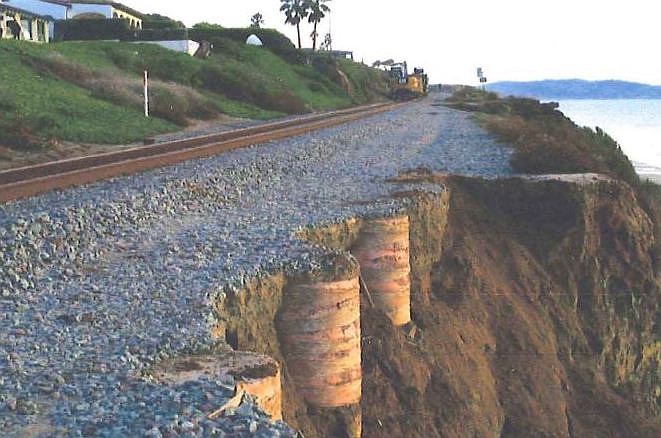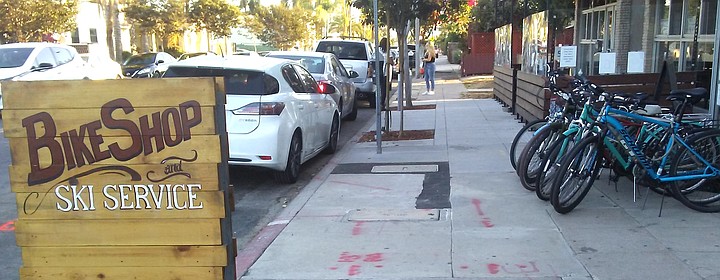 Facebook
Facebook
 X
X
 Instagram
Instagram
 TikTok
TikTok
 Youtube
Youtube

While the Del Mar bluffs and NCTD are in the news I feel it is time to introduce some solutions and common sense especially after reading about the absurdly expensive and disruptive idea of moving the railroad tracks inland (“Good-bye, easy walking to Del Mar beach,” Neighborhood News, September 28). This idea has been well thought out over time and I’ll just give a general overview as an explanation.
Everyone will agree that keeping the rail line where it is will be cheaper. Many will agree that it could stay where it is now long term if the problem with the crumbling cliffs can be satisfactorily addressed and fixed. My plan does fix that problem, assuming some parts of the track are safe from the bluff collapse for several decades without serious intervention while other parts need more immediate attention.
My way to extend the life of the bluffs and rail line is to relieve the stresses on the bluff under and around the track and to reinforce the bluffs at the same time. The way to do that is to build a bridge over the problem areas. However, it would not be just a conventional bridge, but a ‘zero clearance’ or ‘zero elevation’ bridge.
The track bed would clear the top of the bluff by just a few inches so that all the loads and stresses from the track and passing trains are eliminated, but from a distance it would appear as before. This bridge would be supported by columns that would have isolation pads that would also minimize vibrations to the bluff.
These columns are not the concrete monoliths that you see under road bridges or trolley overpasses. These columns are an array of tubular steel posts that are driven into the ground under and around the track. The technology and equipment for screwing these long posts into the ground are well established and it is already used to permanently support buildings and landscaping. Something that may appeal to the environmentalists is that all these columns will be quite invisible and the bluffs wouldn’t be torn up during installation.
As well as supporting the bridge itself, they will reinforce the bluffs in both the stable and unstable areas and therefore extend the life of the bluffs. Think of them as oversized rebar or the fibers in a fiber-reinforced composite. There are no limits to the length of this type of bridge and it could be easily extended if other parts of the bluff continue to erode.
The work could be done incrementally using prefabricated structures to minimize the disruption of the rail service. The main advantage of this concept is that if there is a partial collapse even under the track, movements of the train traffic above would be unhindered as it was not supporting the track in the first place. The failed part could be left alone or rebuilt at leisure. The bridge would need side support structures to strengthen and stabilize the bridge spanning over the fragile areas, just like any other bridge.
Ideally, these sides would be a typical open lattice, high enough to be efficient yet low enough so as not to spoil the sight lines of the nearby home owners and passengers. In order to get some people on board (or to annoy them) I propose the catch phrase – ‘Bluff Longevity Matters’. Unfortunately, I doubt that such a simple logical approach will get much attention when there is the potential for another multi-year, multi-billion dollar boondoggle with unlimited cost overruns out there.

The proposed removal of more than 400 parking spots along 30th street in North Park is a terrible idea (“No delay for deletion of parking on 30th Street,” Neighborhood News, September 28). This will hurt all of the small businesses along this corridor. Many are already suffering due to the restrictions of the Covid pandemic.
I am an avid cyclist who lived in University Heights, Normal Heights, and Kensington for many years. I no longer live in the area but still ride these neighborhoods. There is already an alternative to this misguided plan that has existed for many years. Experienced cyclists who want to ride north or south know a safer way than 30th Street.
Go two blocks west to Utah Street. It is a wide street with dedicated bike lanes and not much traffic. You can ride from north of Adams Avenue down to Upas Street and by-pass the North Park congestion. Save the money of designing this project and the estimated $250,000 environmental review.


While the Del Mar bluffs and NCTD are in the news I feel it is time to introduce some solutions and common sense especially after reading about the absurdly expensive and disruptive idea of moving the railroad tracks inland (“Good-bye, easy walking to Del Mar beach,” Neighborhood News, September 28). This idea has been well thought out over time and I’ll just give a general overview as an explanation.
Everyone will agree that keeping the rail line where it is will be cheaper. Many will agree that it could stay where it is now long term if the problem with the crumbling cliffs can be satisfactorily addressed and fixed. My plan does fix that problem, assuming some parts of the track are safe from the bluff collapse for several decades without serious intervention while other parts need more immediate attention.
My way to extend the life of the bluffs and rail line is to relieve the stresses on the bluff under and around the track and to reinforce the bluffs at the same time. The way to do that is to build a bridge over the problem areas. However, it would not be just a conventional bridge, but a ‘zero clearance’ or ‘zero elevation’ bridge.
The track bed would clear the top of the bluff by just a few inches so that all the loads and stresses from the track and passing trains are eliminated, but from a distance it would appear as before. This bridge would be supported by columns that would have isolation pads that would also minimize vibrations to the bluff.
These columns are not the concrete monoliths that you see under road bridges or trolley overpasses. These columns are an array of tubular steel posts that are driven into the ground under and around the track. The technology and equipment for screwing these long posts into the ground are well established and it is already used to permanently support buildings and landscaping. Something that may appeal to the environmentalists is that all these columns will be quite invisible and the bluffs wouldn’t be torn up during installation.
As well as supporting the bridge itself, they will reinforce the bluffs in both the stable and unstable areas and therefore extend the life of the bluffs. Think of them as oversized rebar or the fibers in a fiber-reinforced composite. There are no limits to the length of this type of bridge and it could be easily extended if other parts of the bluff continue to erode.
The work could be done incrementally using prefabricated structures to minimize the disruption of the rail service. The main advantage of this concept is that if there is a partial collapse even under the track, movements of the train traffic above would be unhindered as it was not supporting the track in the first place. The failed part could be left alone or rebuilt at leisure. The bridge would need side support structures to strengthen and stabilize the bridge spanning over the fragile areas, just like any other bridge.
Ideally, these sides would be a typical open lattice, high enough to be efficient yet low enough so as not to spoil the sight lines of the nearby home owners and passengers. In order to get some people on board (or to annoy them) I propose the catch phrase – ‘Bluff Longevity Matters’. Unfortunately, I doubt that such a simple logical approach will get much attention when there is the potential for another multi-year, multi-billion dollar boondoggle with unlimited cost overruns out there.

The proposed removal of more than 400 parking spots along 30th street in North Park is a terrible idea (“No delay for deletion of parking on 30th Street,” Neighborhood News, September 28). This will hurt all of the small businesses along this corridor. Many are already suffering due to the restrictions of the Covid pandemic.
I am an avid cyclist who lived in University Heights, Normal Heights, and Kensington for many years. I no longer live in the area but still ride these neighborhoods. There is already an alternative to this misguided plan that has existed for many years. Experienced cyclists who want to ride north or south know a safer way than 30th Street.
Go two blocks west to Utah Street. It is a wide street with dedicated bike lanes and not much traffic. You can ride from north of Adams Avenue down to Upas Street and by-pass the North Park congestion. Save the money of designing this project and the estimated $250,000 environmental review.